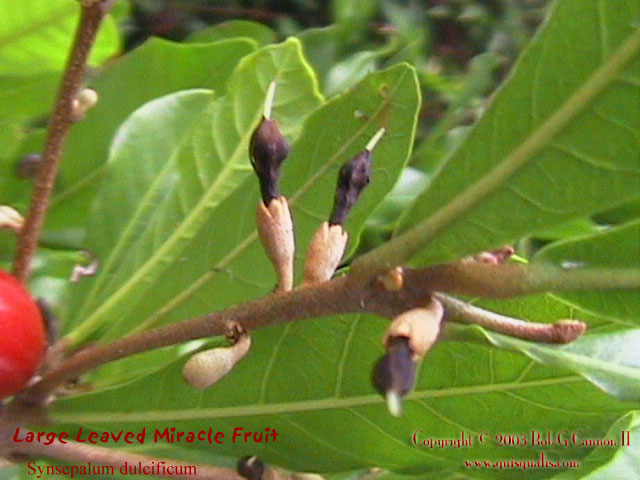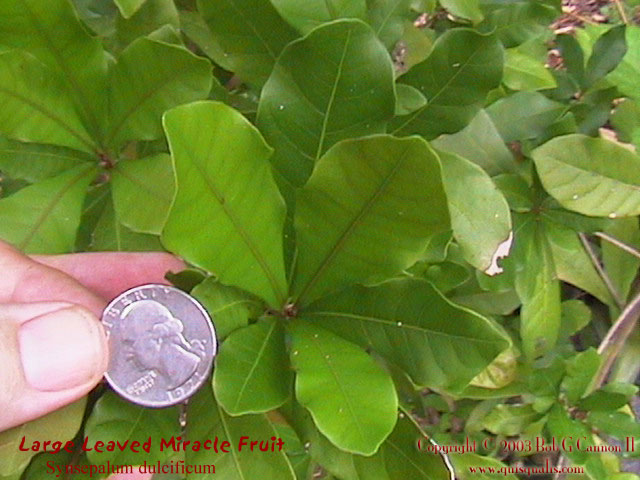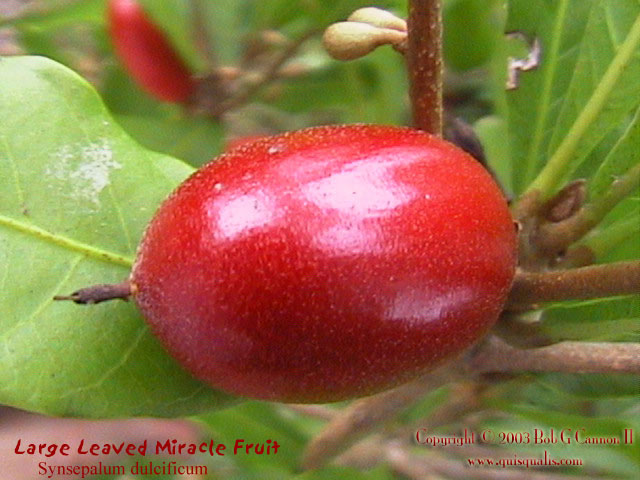Two articles on Miracle Fruit under New Links here!
| Cover |
Contents |
Previous Page |
Next Article |
|
At Florida State University in Tallahassee,
a professor of biophysics. Dr. Lloyd Beidler, began his studies of
miracle fruit in the late 1950's. Together with Dr. Kenzo Kurihara/ he
successfully isolated the active principle, publishing their results in
"Science", Vol. 161, September 20, 1968. Research performed
independently in the Netherlands under the sponsorship of the Unilever
Company culminated in the same year. It was found that a
glycoprotein causes the taste-modification effect, a giant,
'macro-molecule' with a molecular weight of 44/000. The size of this
molecule made it difficult, if not impossible, to synthesize it. This
was
one of the reasons I. M. C. had determined that the miracle fruit had
no
real commercial potential; vast plantations would have been necessary
to
supply enough fruit for the large scale production they envisioned.
Drs. Beidler and Kurihara had access to a sufficient number of fresh berries, which were grown in a greenhouse at the university. The miracle fruits were stored in the deep freeze until needed; 300 at a time were used to make a potent solution through standard scientific procedures. Through their thorough tests, they discovered that the taste-modifying activity was destroyed by heat, or when exposed to organic solvents, and was greatly reduced by exposure to pH above 12.0 or below 2.5 at room temperature. Situations with a pH of 3.7 and temperature of 4°C caused the activity to remain stable for one month. It was also concluded that the protein was basic, and contains no other protein within the active component. It does have bound to it two sugar molecules; the active principle therefore contains a small amount of sugar—6.7%, which was determined not to be an impurity. This is what makes the active principle of S. dulcificum a glycoprotein. Glycoproteins are known to be completely innocent of any toxicity and are readily metabolized by the body. The active principle does not itself have a sweet taste, or any noticeable taste. Placing a quantity in the mouth together with a sour substance initially tastes sour, but will slowly change to a sweet taste as the protein binds gradually to the receptors of the taste buds, modifying their function. Eating more than one fruit does not increase the intensity of the modification. |

|
|
Other research, by Dr. Linda Bartoshuk on
behalf of the U. S. Army, was begun in 1966 at their laboratories in
Natick, Massachusetts. Dr. Bartoshuk's specialty was the psychology of
taste; her interest was in the miracle fruit's military potential.
Since the fruit could make such barely palatable foods as those
consumed in West Africa into culinary delights, it seemed logical that
Army food could also stand similar improvement. After
years of exhaustive research, she read a paper in 1970 at the Army
Research
Conference in West Point, that was very positive in its support of
miracle
fruit. Thorough analysis concluded that no toxic heavy metals were
present.
Huge quantities of miracle fruit concentrate- 3,000 times ordinary
human
consumption — were proven to cause absolutely no ill effects. (In fact,
the health of their laboratory animals was improved by miracle fruit
consumption!)
Foods such as vegetables, meats and others that were not usually sour,
were
not affected, although in some cases the flavor of vegetables did
improve.
It was believed that some foods had flavors which were previously
masked,
and were beautifully brought out by the miracle fruit's principle. This
effect would last for at least an hour—some variation seemed to depend
upon
how long the fruit was held in the mouth before eating other foods
(possibly
due to how well the glycoprotein coated the taste buds). Until saliva
eventually
hydrolyzed the glycoprotein, acidic foods would continue to taste sweet
as the sweet receptors continued to "fire" by exposure to sour foods.
This
has been known to last 18 hours in rare cases. No aftertaste was ever
reported;
although other flavors were slightly enhanced, such as the degree of
saltiness.
It should be noted here that it was also
proven beyond doubt that the central nervous system is not affected by
the miracle fruit, which was a concern of the FDA, which was also
fearful that children could be harmed by the dulling of their natural
taste defenses, allowing them to consume harmful substances. Small
children are most frequently poisoned
by aspirin; miraculin was tested and proven NOT to mask its
characteristically bitter taste. Organic acids- especially citric
acid—are the substances that
are modified to the greatest degree. Battery acid will NOT become a
tasty
drink.
|
|


|
Cultivation: History and Requirements
David Fairchild, renowned botanical explorer, who introduced thousands of important plants to this country, also encountered this phenomenal fruit while visiting an agricultural experiment station in Cameroon in 1919. He consumed a number of the berries, but admittedly did not pay attention to the tale of their properties told him by his native guide. An hour later he was back on his yacht, refreshing himself with a German beer, which tasted unnaturally sweet. Remembering the story, he immediately sampled a lemon, to find it as sweet as a honeyed orange. Naturally, he realized the importance of this plant and gathered all the seeds he could find. He eventually made four introductions, up until 1939, into the United States. Unfortunately, none of the plants survived for very long. Actually, one of the many virtues of miracle fruit is its ease of cultivation — although, like any plant, it politely requests that you learn its likes and it dislikes before inviting it into your home or garden. Those early failed attempts to introduce it into the United States were certainly not due to neglect, as they took place at the U.S.D.A. Plant Introduction Station, Chapman Field, on Old Cutler Road in Miami. Bill Whitman was the first to grow it successfully here. The previous specimens had probably died due to being planted in our alkaline limestone based soils, according to Dr. Robert J. Knight, Jr., research horticulturist now at Chapman Field. Whitman's seedlings were sprouted in acidic peat moss and later planted out in black hammock soil with a pH of 6.4. These plants seem to live for acid—thriving in it, and then converting it! Some plants seem to have more, for lack of a better word, "personality" than others. Consider—its fruit enhances your diet with the healthful benefits of sweetness without calories its beauty adds to your environment and its eagerness to supply you with its bounty will certainly charm you. The miracle fruit is unusually well suited for container growth (once you are aware of its need for acidity). Bill Whitman has seen a seedling all of 7" tall and a cutting of 4" bearing fruit upon their youthful twigs. In Florida, Robert Newcomb's nursery, in 1960, was the first to sell miracle fruit plants, and seeds for $1.00 each. They were descendants of Bill Whitman's original Panama discovery. Christopher Whitman had a nice little cottage industry going as a youngster; his father told me that he (Bill) would eat 100 berries at a time to clean them, so that Chris could sell them to Fred Saleet of The Banana Tree in Pennsylvania at 25 cents each. If ever there lived a person who was an example of the benefits—and harmlessness—of the miracle fruit, it's Mr. Whitman, having consumed countless thousands of the berries since 1958 and doing just fine! (William (Bill) F. Whitman, Jr passed away in his sleep at the age of 92 in 2007. He read and enjoyed this article and commented that it was the best of any article on miracle fruit that he had ever seen. - web editor) Although not thought to be frost tolerant, they
have been observed growing in unprotected locations as far north as Tampa.
It is not a fast growing plant, which is another benefit for those who would
like to grow it in their house or greenhouse. It thrives under warm temperatures,
and high humidity, like most descendants of rainforest denizens. There are
never any rules in the natural world that are absolute. There are too many
variables. In the 1970's, for example, during the big push to bring miracle
fruit into the daily diet of Americans, the best individual plants were sought
out and bred for their characteristics—fastest growth, highest yield, biggest
fruit, as horticulturists always seek to do. What happened to those thousands
of well bred S. dulcificums in those plantations in Jamaica, Puerto Rico
and Dahomey is not known by this writer. Bill Whitman has bred a larger-leaved
variety that thrives in his Bal Harbour grove. Dr. Robert McNaughton has
a "giant" miracle fruit in Coconut Grove garden (refers to the taste of the
fruit, not the tree itself.)
|
|
Grow The Dream
It's just a shrub, with a varying number of small red fruits. And at one time I was skeptical of its potential, its safety, its practical use in everyday life. I am now convinced that this is a fruit that is truly a gift to humanity; not a perfect solution, but a way to improve our diets and our health with intelligent usage. I was glad to discover that research is still going on, especially in Japan, where Dr. Kurihara and his wife are guiding the development of sugar replacements, using the miracle fruit, among other plants. This plant deserves to become much more than a charming oddity in our gardens, a practical joke to play upon our visitors. It deserves our respect for its potential to revitalize our dietary habits. It does takes a bit of re-education to change our wicked, sugary ways and fully utilize the unique properties of the miracle fruit. Modem day life demands everything be ultra convenient; using the miracle fruit has been not as easy as many of us would have wished. One scenario involves eating a single fruit before the morning grapefruit, a la Bill Whitman; or to fully enjoy the delights of a bowl of tart strawberries. However, part of the problem of utilization involves sweetening coffee and soft drinks. It will make beer taste like lemonade! But lemons taste like lemon sherbet. It is unfortunate that heat destroys the active principle, so that canning, jams, preserves, baking, drying, etc. are impossible. The fruits can be held for a short period of time by refrigeration or freezing. There was a powdered concentrate available briefly in the 1970's, produced by that now-defunct Mirlin-Corporation, that would've made life a lot sweeter and less fattening for us all with great convenience. We have the FDA to thank for its absence. It is certainly within the realm of
possibility that every household could be graced with at least one
miracle fruit plant. A 10 inch plant is happy in a one gallon pot, in a
medium containing peat moss or other acidic well drained soil mixture.
One that size will flower and fruit at least twice a year, probably
more frequently. Eventual size depends on where the plant is grown; a
plant 10 years old might be only 3 feet tall. Bill Whitman's 20 foot
beauty is about 25 years old. He has harvested 850 fruits at one time.
(See TFNews, February 1992, page 2 for a photograph of this beautiful
tree.) I have seen 6 foot trees in pots that were about 10 years old. A
lot depends upon the grower!
Water about every three days—as in every houseplant, DON'T OVER WATER; feel the soil first. If your indoor humidity is not high enough, create a mini greenhouse by placing a clear plastic bag, supported by three or four sticks thrust into the soil, over the entire plant. Do not let intense sun fall upon the plant when in the mini greenhouse or the poor thing will cook! The bag can cover the plant for six months with no ill effects; remove it when the humidity is 50% or higher for extended periods. When removing it, do so over two or three days, and from the bottom up. Whether inside or out, fertilize on a regular schedule. Some use an azalea type fertilizer; Bill Whitman recommends a 20-20-20 soluble plant food; 1/4 tsp. in a gallon of water, applied while watering every other week. Suitable brands are Peters, Hyponex or Hy-Gro. Sources of miracle fruit plants or seeds? A number of your fellow RFCI members grow Synsepalum dulcificum, and make seeds available regularly through the Seed Bank or at the monthly meetings. Pat Hartmann, known as the Blueberry King of Michigan, will eventually be offering thousands of miracle fruit plants for sale; Bill Whitman has "been sending him seeds for years". Write for a free catalog to Hartmann's Plantation, P.O. Box E, Grand Junction, Michigan 49056 (904) 468-2087/468-2081. Before going out to the garden to check on my own little miraculous berry, I must effusively thank Mr. William Whitman for his time, knowledge, advice and generosity in supplying various otherwise unobtainable literature that made this article possible. And now off to see how close I am to being able to play the old sweet lime trick on visitors to my house! |
|
| Cover |
Contents |
Previous Page |
Next Article |